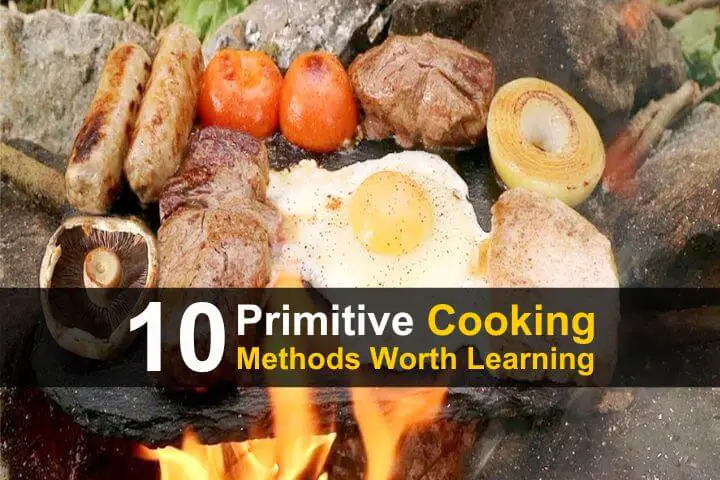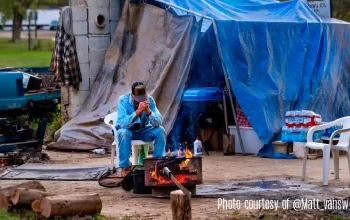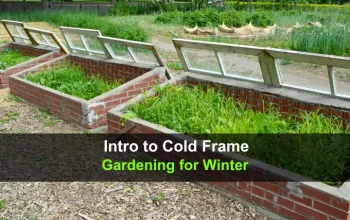Estimated reading time: 14 minutes
When modern conveniences fail, knowing how to cook with primitive methods becomes one of the most important survival skills to know. Believe it or not, the earth provides the necessities for almost any time of cooking, with a little bit of elbow grease, of course.
Whether you’re an outdoor enthusiast exploring new terrains or a survivalist preparing for a SHTF scenario, this guide will walk you through 10 different cooking methods that will prepare you for food preparation in almost any environment on the planet.
Want to save this post for later? Click Here to Pin It On Pinterest!
1. Open-Fire Cooking

Open-fire cooking is one of the most primitive and versatile methods of preparing food. Involvement in this process requires building a stable fire using wood as the fuel source. Once the fire is established, it can be used to roast, grill, or boil food directly over the flames or on hot coals.
Even though the method may be primitive, it can still be improved upon. For example, making your cooking accessories including skewers, grill racks, or even flat stones can greatly improve cooking efficiency.
Benefits:
- Imparts a unique smoky flavor to food that is difficult to replicate with modern cooking methods.
- Encourages a connection with nature, enhancing the overall outdoor experience.
Challenges:
- Maintaining a consistent cooking temperature can be difficult, which may result in unevenly cooked food or burnt offerings. Flare-ups are common and can further complicate the process.
- Wind, rain, and other weather conditions can significantly impact the fire, making it challenging to sustain a flame or control the heat.
Here’s a guide to campfire cooking.
2. Pit Cooking
Pit cooking is one of the oldest culinary techniques known to humanity, dating back thousands of years. This method involves digging a hole in the ground, which serves as an earth oven, where food is cooked using heated rocks and covered with soil or leaves.
The procedure for pit cooking begins as primitively as it could, by digging a hole, preferably in soft ground. Once the pit is ready, stones are heated in a fire until they are red-hot. These stones are then placed at the bottom of the pit.
A rack can be made (or bought) that sits on top of the rocks. Food, often wrapped in leaves or heavy-duty tin foil, is added on top of the rack, or directly onto the hot stones. The pit is then covered with soil, trapping the heat and steam inside, which cooks the food slowly over several hours.
Benefits:
- Offers a sustainable and energy-efficient cooking method, utilizing readily available natural resources. No gear is required.
- Great for preparing large quantities of food, including whole animals.
Challenges:
- Preparing the pit and heating the stones requires time and effort, making it less practical for quick meals.
- Monitoring the cooking process is difficult once the pit is covered, which might result in overcooked or undercooked food.
- Environmental factors like soil composition and moisture levels can affect the efficiency of the cooking process.
Here are detailed instructions.
3. Stone Boiling
Stone boiling is a traditional cooking technique that involves heating stones in a fire and then placing them into a container of water to bring it to a boil. This method is particularly useful in situations where direct-fire cooking is not practical or when specific food items require boiling.
The procedure for stone boiling begins by selecting durable, non-porous stones that can withstand high temperatures without cracking. These stones are heated in a fire until they are red-hot. Meanwhile, a heatproof container, typically made from materials like wood, leather, clay, or even animal stomachs, is filled with water and the food that needs to be cooked.
Once the stones are sufficiently heated, they are carefully transferred into the water-filled container using sticks or tongs. The hot stones transfer their heat to the water, bringing it to a boil and cooking the food.
Benefits:
- Stone boiling allows for the preparation of soups, stews, and other boiled foods without the need for metal cookware.
- It is a versatile method, enabling the boiling of water in containers that would otherwise not be fireproof.
- This technique can be used to purify water by bringing it to a boil, making it safe to drink. Although it will still be quite dirty you will need to filter it through something before drinking.
Challenges:
- Selecting and transporting suitable stones can be labor-intensive.
- Stones may break if they are porous or contain moisture, which poses a safety risk. Stay away from submerged rocks.
- Continuously adding and removing stones to maintain the boiling temperature requires constant attention. You will need to chop up a significant amount of firewood and keep a hot bed of coals ready to go.
Here are some video instructions.
4. Clay Baking
Clay baking is a traditional cooking technique that involves encasing food in a layer of clay and baking it on a fire. This method is particularly useful for retaining moisture and flavor in the food while providing consistent, high heat.
The procedure for clay baking begins by preparing the food, often whole animals like fish or poultry, as well as vegetables. The food is then wrapped in leaves or other natural materials to provide an additional layer of protection against heat.
A thick layer of moist clay is then applied around the wrapped food, ensuring that it is completely sealed. This clay-encased parcel is then placed directly into hot coals or an open fire. As the clay hardens and heats up, it cooks the food inside evenly while keeping it moist.
Benefits:
- Clay baking helps keep meat tender and juicy as the clay seal traps moisture.
- This method does not require any specialized cookware, making it accessible and practical in survival situations or outdoor settings.
- The hardened clay shell can serve as a protective barrier, preventing the food from burning even in direct contact with the fire.
- Fun to crack open.
Challenges:
- Finding and preparing suitable clay can be labor-intensive and time-consuming.
- Ensuring the clay is applied evenly and thick enough to form a solid barrier requires practice and skill. Build one wall too thin and you could burn the food inside.
- Monitoring the cooking process is difficult, and the clay shell must be broken open carefully to avoid damaging the cooked food inside.
Here are some video instructions.
5. Hot Rock Cooking

Cooking food on heated flat stones is a traditional technique that involves heating smooth, flat stones in a fire and then using them as a cooking surface, like a frying pan. This method is particularly useful for grilling meats, and vegetables, and even baking flatbreads. This is largely because the rocks will heat evenly over a ire.
The procedure for cooking on heated flat stones begins by selecting suitable stones that are flat, smooth, and non-porous to withstand high temperatures without cracking. Granite or soapstone are examples. Avoid rocks that are from riverbeds as they may have water deep inside them.
These stones are then placed in a fire and heated until splashing water on them makes them sizzle. Once heated, food can then be placed directly on the hot stones, where it cooks evenly due to the retained heat.
Benefits:
- Cooking on heated flat stones provides a versatile cooking surface that can be used for grilling, searing, and baking.
- The method requires no specialized cookware, making it accessible in various outdoor and survival scenarios.
- The natural heat retention of the stones provides consistent heat for even cooking.
Challenges:
- Selecting and preparing suitable stones can be labor-intensive and requires knowledge to avoid picking stones that could crack or explode due to trapped moisture.
- Transporting and handling hot stones safely requires caution and proper tools, such as tongs or thick gloves, to prevent burns.
Here’s how to cook food on a hot rock.
6. Ash Cooking

Ash cooking is a primitive cooking technique that involves burying food directly in the hot ashes of a fire. This method is particularly useful for roasting root vegetables, tubers, and meat, as the ashes provide consistent and gentle heat that penetrates even tough foods.
The procedure for ash cooking begins by building a fire and allowing it to burn down until only hot embers and ashes remain. The food, often wrapped in leaves or aluminum foil for added protection, is then buried directly in the hot ashes.
Depending on the size and type of food, the cooking time can vary but typically ranges from 20 minutes to a few hours. Once cooked, the food can be carefully retrieved from the ashes and unwrapped to be eaten.
Benefits:
- No need for fancy gear, just some good firewood and patience.
- The method imparts a distinctive smoky flavor to the food, enhancing its natural taste.
- It is an accessible technique in outdoor and survival scenarios where basic cooking tools may not be available.
Challenges:
- Ensuring the food is properly wrapped or protected to prevent it from becoming too ashy can be tricky.
- If the remaining ash is too hot it can burn through the wrapping and damage the food inside.
Here’s how to cook potatoes in ashes.
7. Leaf Wrapping

Much as the title of this section suggests, leaf wrapping involves rolling your food in large non-toxic leaves. This method is particularly useful for steaming or roasting meats, fish, and vegetables, as the leaves trap moisture and flavors while providing a natural barrier against direct heat.
The procedure for leaf wrapping cooking begins by selecting suitable leaves, such as banana or corn husks, which are large enough to fully encase the food. The food, fully seasoned and accompanied by herbs or spices, is placed in the center of the leaf.
The leaf is then wrapped tightly around the food, and secured with natural twine or additional leaf strips to prevent it from coming undone during cooking. The wrapped food can then be placed on hot coals, steamed over boiling water, or even buried in hot ashes for a gentle roasting.
Benefits:
- Leaf wrapping helps retain moisture and flavors within the food, resulting in tender and aromatic dishes.
- This method does not require any specialized equipment, making it ideal for outdoor and survival situations.
- The natural oils and essences from the leaves can impart unique and complementary flavors to the food.
Challenges:
- Finding and preparing suitable leaves can be labor-intensive and requires knowledge to ensure they are non-toxic and appropriate for cooking.
- Wrapping the food securely to prevent leaks or burns requires practice.
- Monitoring the cooking process can be difficult, as the food is encased and not easily visible. The nice thing is that it is pretty difficult to overcook something encased in thick leaves.
Here’s how to cook food in leaves.
8. Smoking

This method is particularly useful for preserving and flavoring meats, fish, and even vegetables, as the smoke imparts a distinctive taste while also acting as a preservative.
The procedure for smoking food begins by selecting suitable wood, such as hickory, oak, apple, or cherry, known for their flavorful smoke. The food is often seasoned and may be marinated or cured before smoking.
A fire is built using the chosen wood, and once it produces a steady stream of smoke, the food is placed either on a rack above the fire or in a designated smoking chamber. The process can be done hot (temperatures between 165°F and 250°F) or cold (temperatures below 90°F), depending on the desired outcome and type of food being smoked. Smoking times can vary greatly, ranging from a few hours to several days.
Benefits:
- Smoking helps preserve food, extending its shelf life by reducing moisture content and deterring bacterial growth.
- This method imparts a rich, smoky flavor that enhances the natural taste of the food.
Challenges:
- Maintaining a consistent smoke and temperature requires constant attention and experience.
- The long cooking times can be impractical for quick meals. This is a slow climb to success.
Here’s how to build a primitive smokehouse.
9. Solar Cooking

Solar cooking is particularly useful in sunny climates and can be used to prepare a variety of dishes, from meats and vegetables to breads and stews.
This could be considered one of the more advanced, primitive methods of cooking. Solar cooking begins by selecting a suitable solar cooker, which can range from simple homemade devices like box cookers and parabolic reflectors to commercially available models.
The food is prepared and placed in a dark, heat-absorbing container, often with a lid to retain moisture and heat. The solar cooker is then positioned to maximize exposure to direct sunlight, usually by adjusting the angle to face the sun. Cooking times can vary depending on the type of food and the intensity of the sunlight but typically range from one to several hours.
Benefits:
- Solar cooking eliminates the need for traditional fuel, making it a sustainable and cost-effective cooking method.
- This method produces no smoke or emissions making it a great stealth option
- It can be inexpensive to build or purchase, making them accessible in many different settings.
Challenges:
- Solar cooking requires clear, sunny weather.
- Cooking times are dependent on the intensity of the sunlight.
- Frequent adjustments to the solar cooker’s position are necessary to maintain optimal exposure to the sun.
10. Cooking Using Bamboo Tubes
Bamboo cooking is a primitive method that utilizes hollow bamboo stalks as cooking vessels. This technique is used in tropical regions where bamboo is abundant and can be used to prepare a variety of dishes, from rice and soups to meats and vegetables.
This could be considered one of the more resourceful and sustainable methods of cooking. Bamboo cooking begins by selecting fresh, green bamboo stalks that are thick-walled and free of cracks.
The food is then prepared and placed inside the hollow sections of the bamboo. The open end of the bamboo is often sealed with leaves or another piece of bamboo to retain moisture and heat.
The filled bamboo stalks are then placed directly over hot coals or an open fire, turning occasionally to ensure even cooking. Cooking times can vary depending on the type of food and the intensity of the heat.
Benefits:
- Bamboo cooking is eco-friendly and does not require any specialized gear.
- The natural properties of bamboo help to retain moisture in the food.
- This method produces minimal waste, as the bamboo can be composted after use.
Challenges:
- Finding suitable bamboo stalks can be challenging and requires knowledge to ensure they are fresh and appropriate for cooking.
- Managing the heat and ensuring even cooking without burning the bamboo can be difficult and requires careful attention.
- Bamboo cooking is best suited to environments where bamboo is readily available, limiting its practicality in other regions.
Here’s how to cook fish in bamboo tubes.
Final Thoughts
You may have noticed a theme with a lot of these methods, they all create a similar cooking environment. Once you understand the basic principles, you can modify these techniques for your situation. Learning one (or all) of these techniques will equip you with the means to cook food in any kind of survival situation, whether it be in the wild or in your city.
Like this post? Don’t Forget to Pin It On Pinterest!
You May Also Like:



